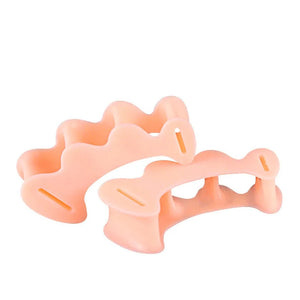Foot problems, especially deformities like hallux valgus (commonly known as bunions), are more than just cosmetic issues—they can impact balance, gait, and overall mobility. While surgical options exist, many physiotherapists and healthcare professionals are turning to conservative treatments to manage these conditions. One surprisingly simple yet increasingly researched tool? Toe separators.
What Are Toe Separators?
Toe separators are small devices placed between the toes to help realign them. They’re often made of gel, foam, or silicone and are commonly used in the treatment of bunions. But recent research suggests that their therapeutic value might extend far beyond just bunion correction.
What the Research Says
A systematic review conducted by Hanna Krześniak and Aleksandra Truszczyńska-Baszak looked into the role of toe separators in physiotherapy. Their goal? To evaluate existing scientific literature and see how effective these tools really are.
Here’s what they found:
• The review included 10 studies out of over 1000 initially identified from databases like PubMed, Science Direct, and Web of Science.
• These studies involved various participant groups, with sample sizes ranging from 9 to 90 people.
• Toe separators were primarily used for hallux valgus correction, but several studies also reported benefits for:
• Neurological patients (such as those recovering from a stroke)
• Dermatological conditions
• Improving lower leg muscle function during walking
Gaps in the Evidence
Despite these promising applications, the review highlighted some important limitations:
• Many studies lacked details about their methods or the specific types of toe separators used.
• There was significant variation in the materials, designs, and usage guidelines across studies.
This makes it difficult to draw firm conclusions about best practices or standardized treatment protocols.
Final Thoughts
Toe separators may seem like a simple intervention, but their potential in physiotherapy shouldn’t be underestimated. They offer a non-invasive, affordable, and easy-to-use option for patients dealing with foot deformities and related issues.
However, as the authors of the review point out, there’s still a need for more rigorous, high-quality research to fully understand how and when these tools should be used. As we wait for more evidence, toe separators remain a practical and promising tool in the physiotherapist’s toolkit.
Toe Separators as a Therapeutic Tool in Physiotherapy-A Systematic Review
Hanna Krześniak, Aleksandra Truszczyńska-Baszak
This blog post is purely for informational purposes only and should not replace professional medical advice. It is essential to consult with a healthcare professional for an accurate diagnosis and personalized treatment plan based on your specific condition.

